An inside look: physical activity tracking
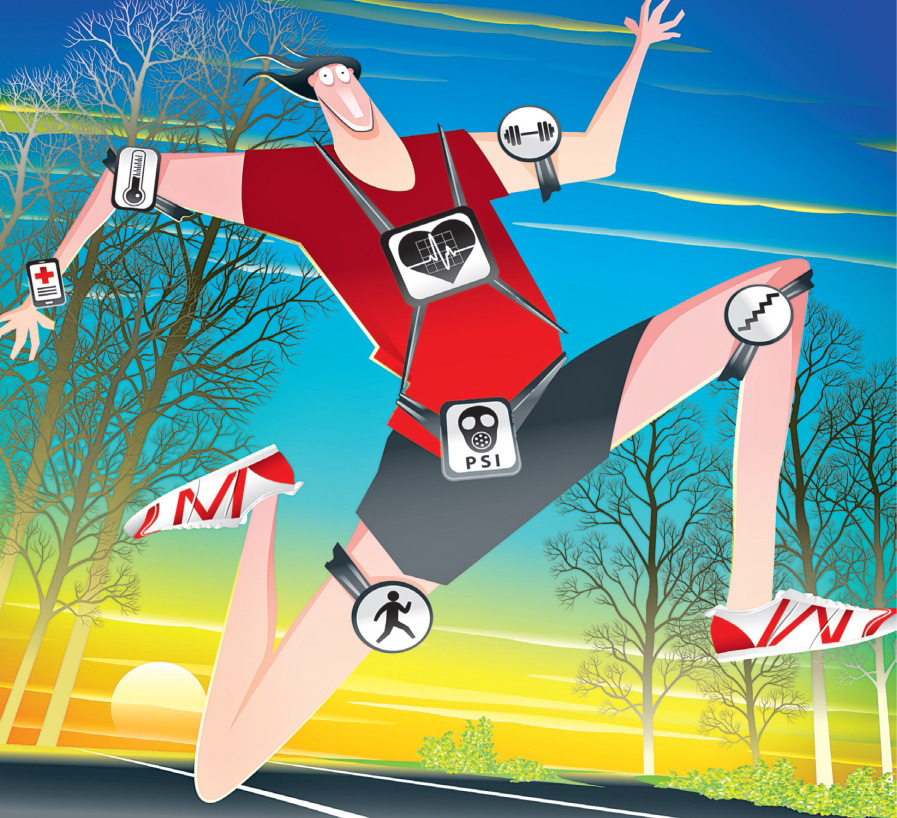
Source
Scientists have one small weakness - to set up experiments and analyze the results. I set a couple of experiments dedicated to monitoring physical activity for 24 hours. Details, measurement technique, comparison of the results of the number of heartbeats are presented under the cut for two days with low and high levels of physical activity.
opening speech
Fitness tracker in my life appeared relatively long ago - almost two years ago. It was a regular bracelet that counted the number of steps, then a chest strap for measuring the pulse was already purchased. At that time, it seemed that one had only to start wearing this miracle of scientific and engineering thought, follow the advice of a soulless program on the phone, which impartially monitors physical activity and the highway to healthy life is open. However, life has put everything in its place.
Even on Habré and GT there are a lot of articles devoted to a bright future of telemedicine and "cloud" doctors , who can do that and make a diagnosis according to "human telemetry." There are even reports that fitness trackers can save a person’s life by recognizing anyheart disease or can determine the source of the earthquake is not worse than the geological service.
On the other hand, doctors still do not know or are “not sure” of the applicability of data from fitness trackers for a “personalized” approach to medicine. Where to store this amount of information? Fitness tracker measures pulse every 5 seconds, giving out more than 10,000! points per day, it is about 0.5 MB in a two-column CSV, 200 MB per year. But you also want to accumulate statistics, see the dynamics in the context of 5-10 years. How to handle? Over 300,000! points for the month, not every graphing program is such a master. And most importantly, why?
There you can add some more questions: to what extent are the data obtained by recurrent fitness trackers? What is the error and probability of error?
In general, it turns out that there are more questions than answers, so below I will describe a full-scale experiment and summarize some obvious and not very good results. I will also try to answer the question: who are they, fitness trackers - a useless toy or a valuable tool that allows you to collect a huge array of data for personalized medicine?
Types of heart rate monitors
Today, there are two fundamentally different schemes for measuring heart rate or heart rate (HR), or HR for short (heart rate).
The first of them and the most popular, perhaps - the green laser. From the manufacturer to the manufacturer and from model to model, only the position of the sensor and the number of LED lasers around it change.
The principle of operation is simple. In the blood there is heme (hemoglobin), which dyes the blood in a bright red color, this hem intensively absorbs in the green part of the spectrum. The blood, even in the smallest vessels, pulses with the same frequency as the heart, which provides blood flow. We direct the laser to the skin and measure the pulsation of the reflected green light, from where we calculate the pulse.
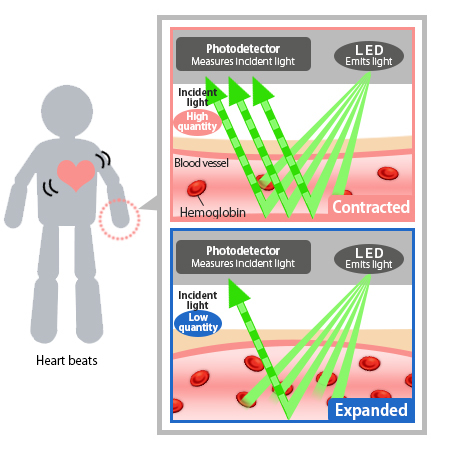
The principle of operation of the laser heart rate monitor. Source
Another type of heart rate monitor works on the principle of ECG , with the only difference that instead of a dozen electrodes only two are used.
A pair of electrodes is fixed on the chest (as shown by my practice, you can not even wet it). The potential difference, which corresponds to heartbeats, is recorded using a separate mini-computer that transmits data to external devices via BlueTooth.
NB: It is interesting that, for example, some simulators support the HR function via the BT channel, so during training the data is automatically displayed on the display. Below is an example of how this looks on Concept 2 rowing machines:
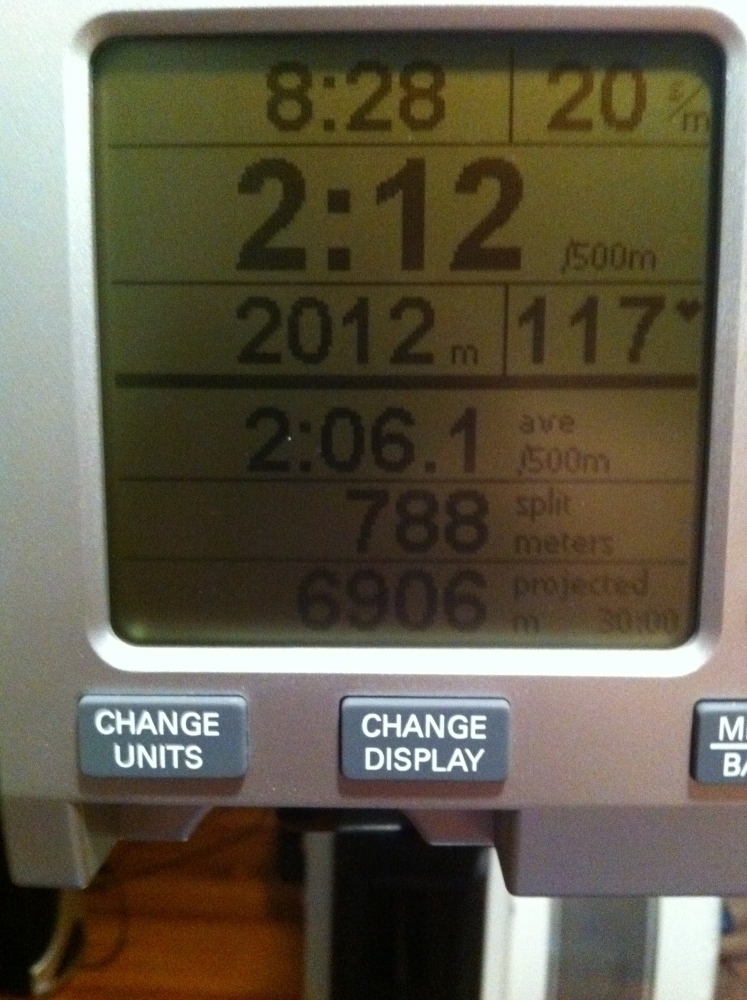
Source
Reader will ask the question, what is better? Writing a direct and unequivocal answer is difficult.
If there are no diseases of the cardiovascular system and accurate measurements are needed only during exercise (athletes, for example), then a bunch of just a bracelet and a sensor on the chest would be the best choice. If the task is to monitor the pulse around the clock (for example, because of heart problems), then choose a bracelet with a built-in sensor. Full comparison with the analysis of certain aspects in English is given here .
Literally two words about the reliability of the data. On the same site Wareable.com there is an interesting article.dedicated to testing the accuracy of the data obtained by different sensors. It turns out that the laser sensor produces "reproducibility" of about 85% at ± 5 beats / min, while the chest strap allows you to reach 91%.
From myself I’ll add that my heart rate monitor specifically measures the pulse every 5 seconds, that is, if there were 5 beats in 5 seconds, then HR will be calculated as 60 beats / min. In the relaxed position, the hand-measured pulse was 60 beats / min, and the chest strap gave values from 58 to 63 — quite acceptable accuracy.
But back to our sheep ...
Part experimental
To monitor the pulse, I wore a chest heart rate monitor in conjunction with a fitness bracelet for several visits with breaks for recharging and unloading data: working day + evening at home and separately - night. Bracelet with heart rate monitor are synchronized via Bluetooth.
In order not to spoil and avoid accusations of advertising, I’ll give specific models here (who needs to open and look).
DARPA Super Secret Development
A bunch of Polar Loop with a Polar H3 sensor. On Habré even the review on them is available.
Next, we will break apart the usual “office” day (thanks to the thesis, there were quite a few of them) and compare it with the day when we had to endure much of the time “on foot” (she works in the laboratory). As a bonus to this article there will be pulsograms from a workout in the gym and a mountain hike.
Office Day
In order not to torment, I will immediately give the general picture, which is presented in the figure below. In fact, this is a 24-hour pulsogram of a typical “office hamster”.
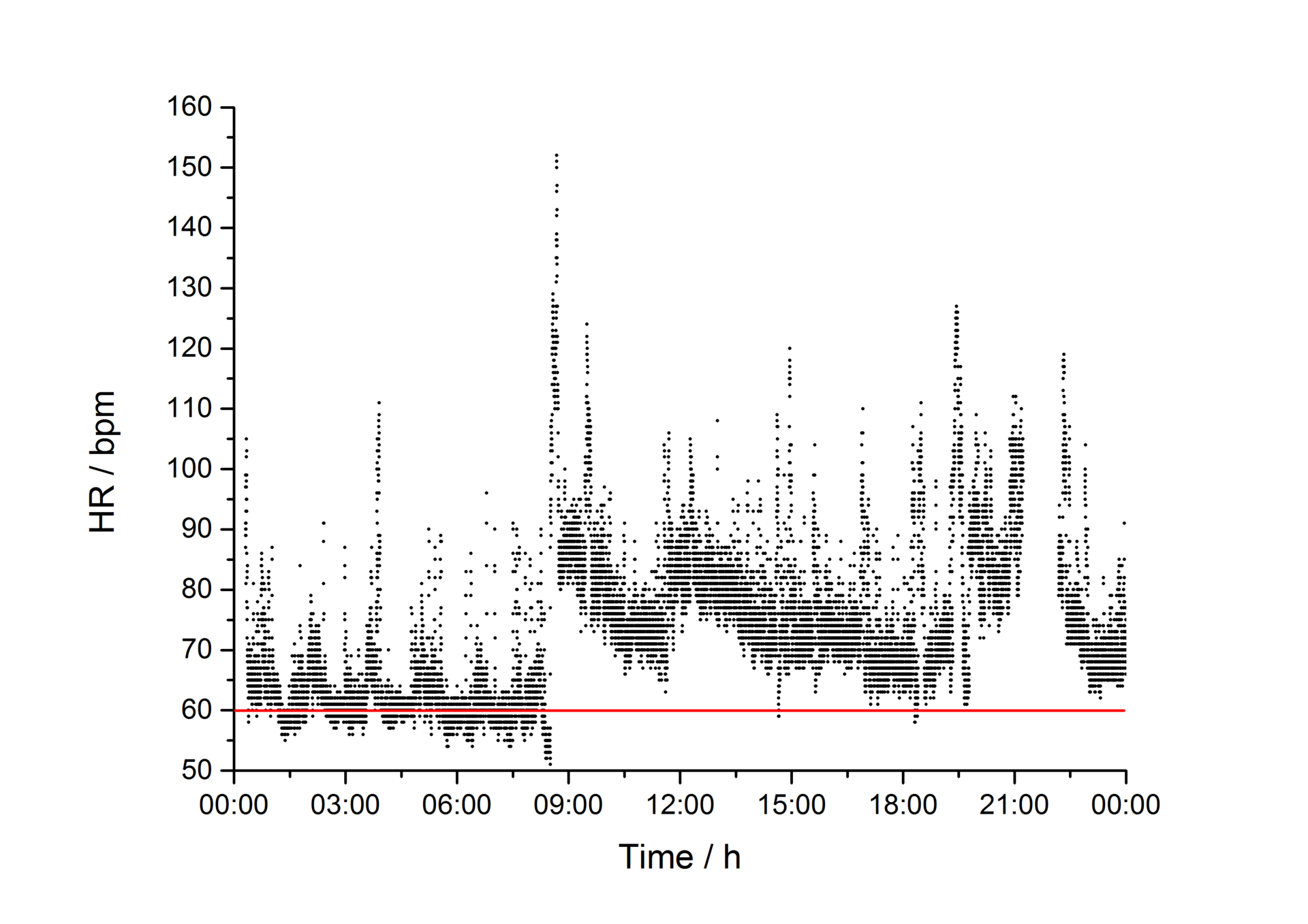
Looking ahead, I will say that any physical activity has a long trace of “relaxation” when the pulse returns to “normal” for 30–40 minutes. A "rise" pulse around 9-30 and 12-00 is two cups of coffee.
But let's take a closer look at it ...
We will start with a wake up at about 7-30 and a race to the train, on which I usually get to work. After waking up, the pulse jumps from 60 (so to speak healthy sleep) to 80-90 beats / min (charges and moving around the house). Then a light jog to the train and the pulse goes above 120 beats / min. Then the rest time in the train, 40 minutes - nothing happens and the pulse returns to 80 beats (work on the computer, view the news in the phone). And, of course, the arrival and walk to work is relatively quiet step, and all the bursts - staircases.
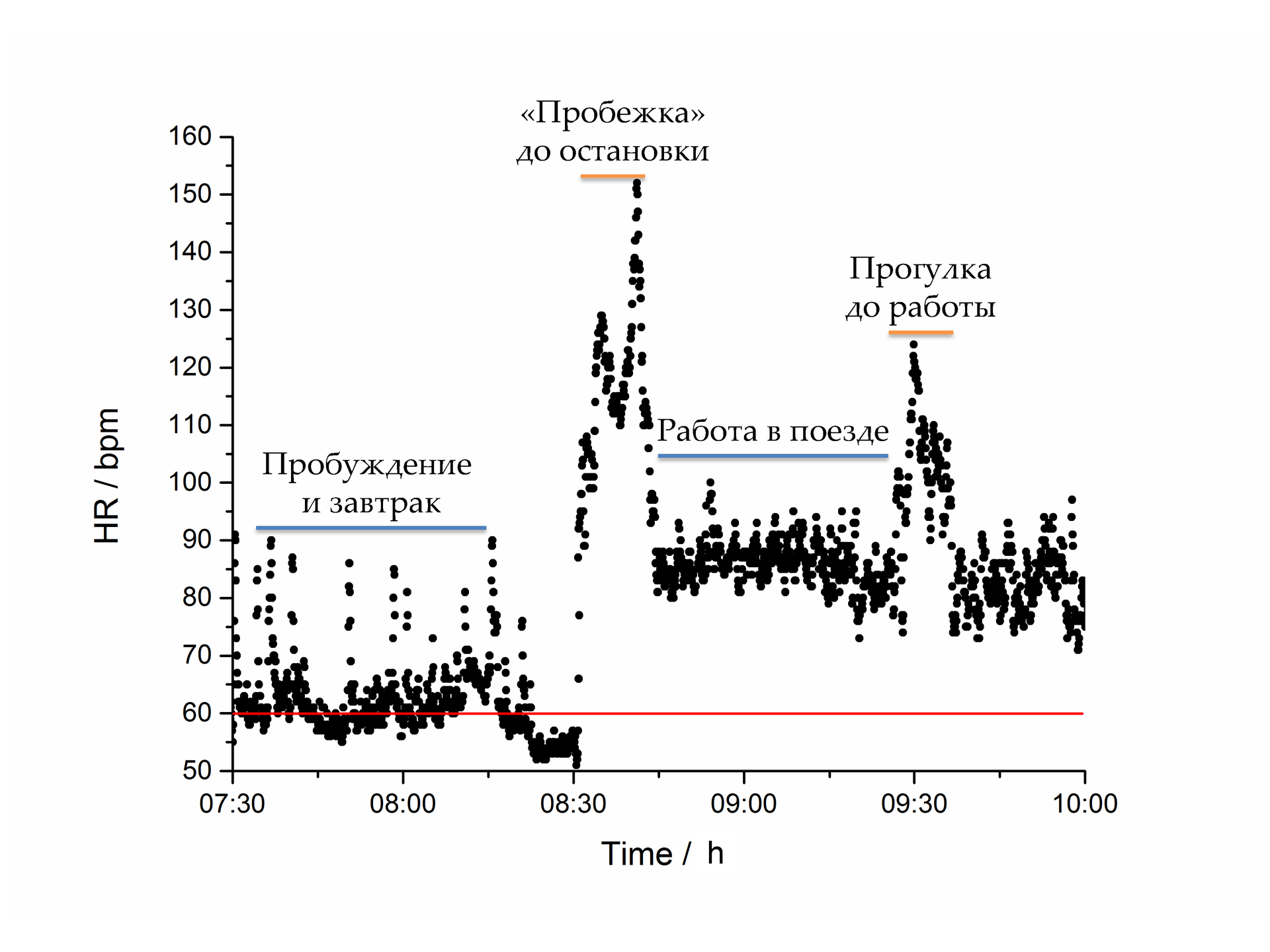
Next, the first
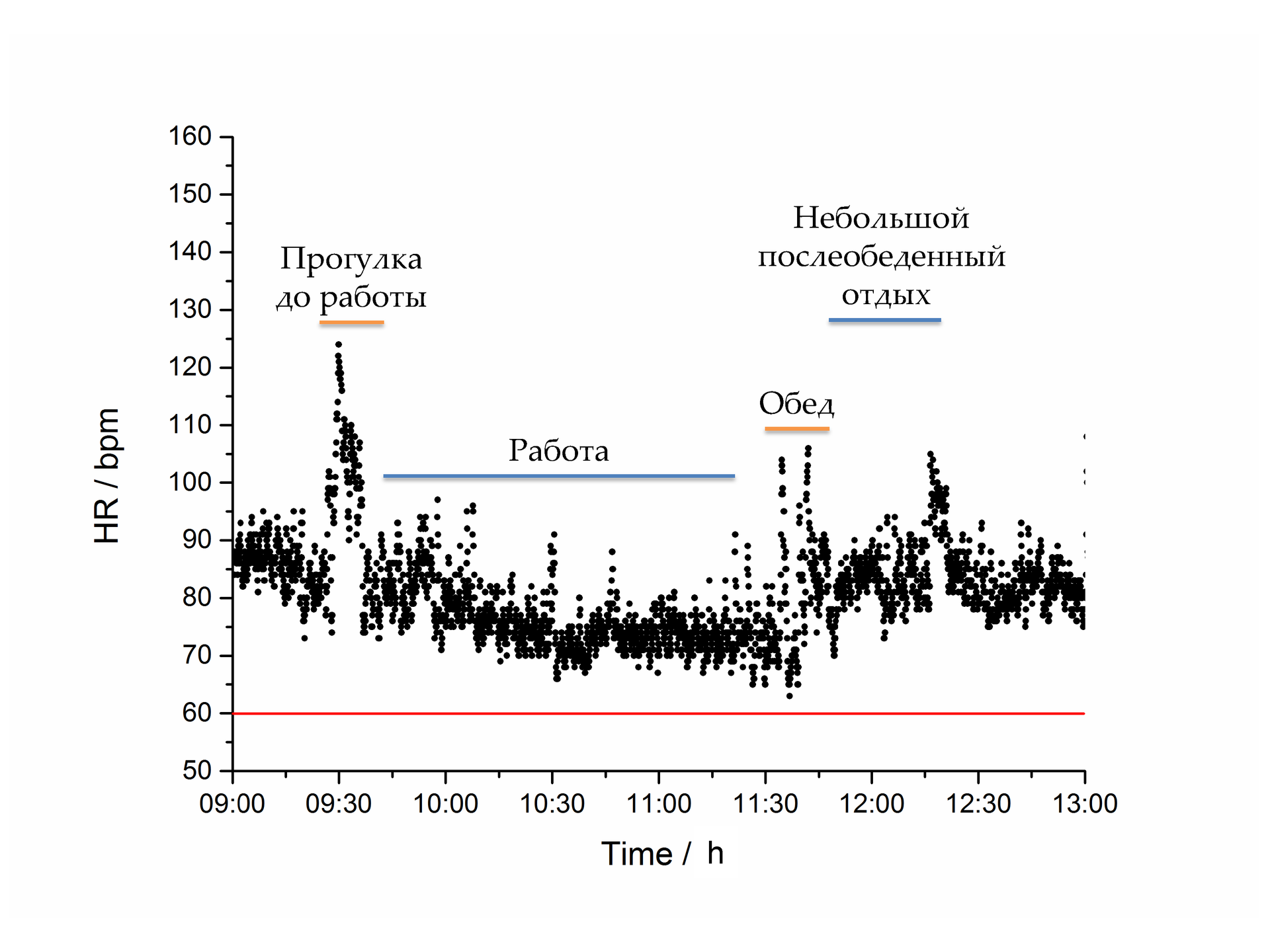
The second half of the working day - without changes, around 70-80, periodically the bracelet reminds that it is time to show some physical activity - you have to obey the mindless piece of iron on your wrist and walk around the office.
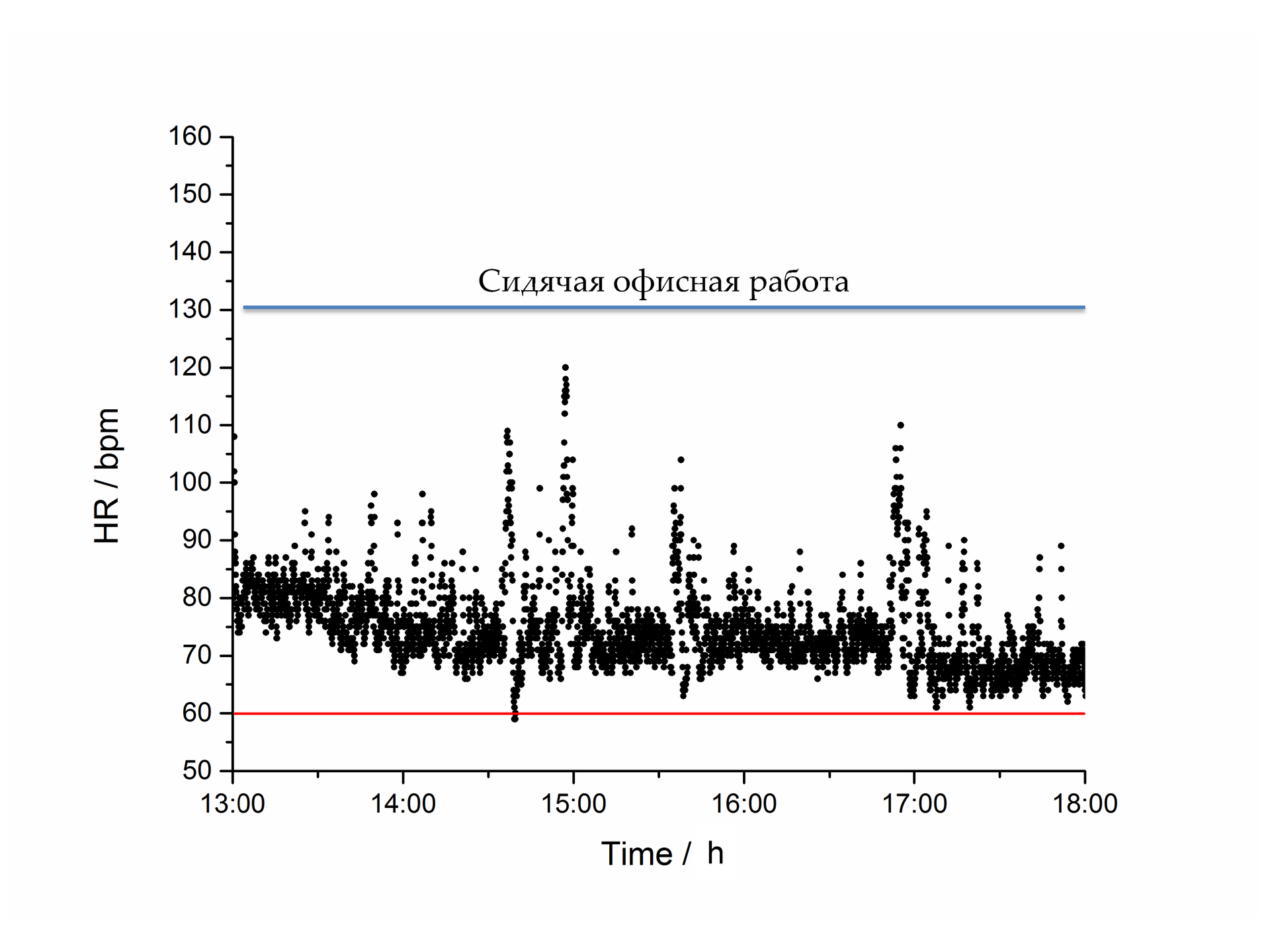
The end of the working day. It is necessary to get to the train, the pulse jumps again to 90-100 beats / min (I usually leave at the very last moment). And again, 40 minutes of sitting mode. Then a long and long climb to the mountain, dinner and some household chores.
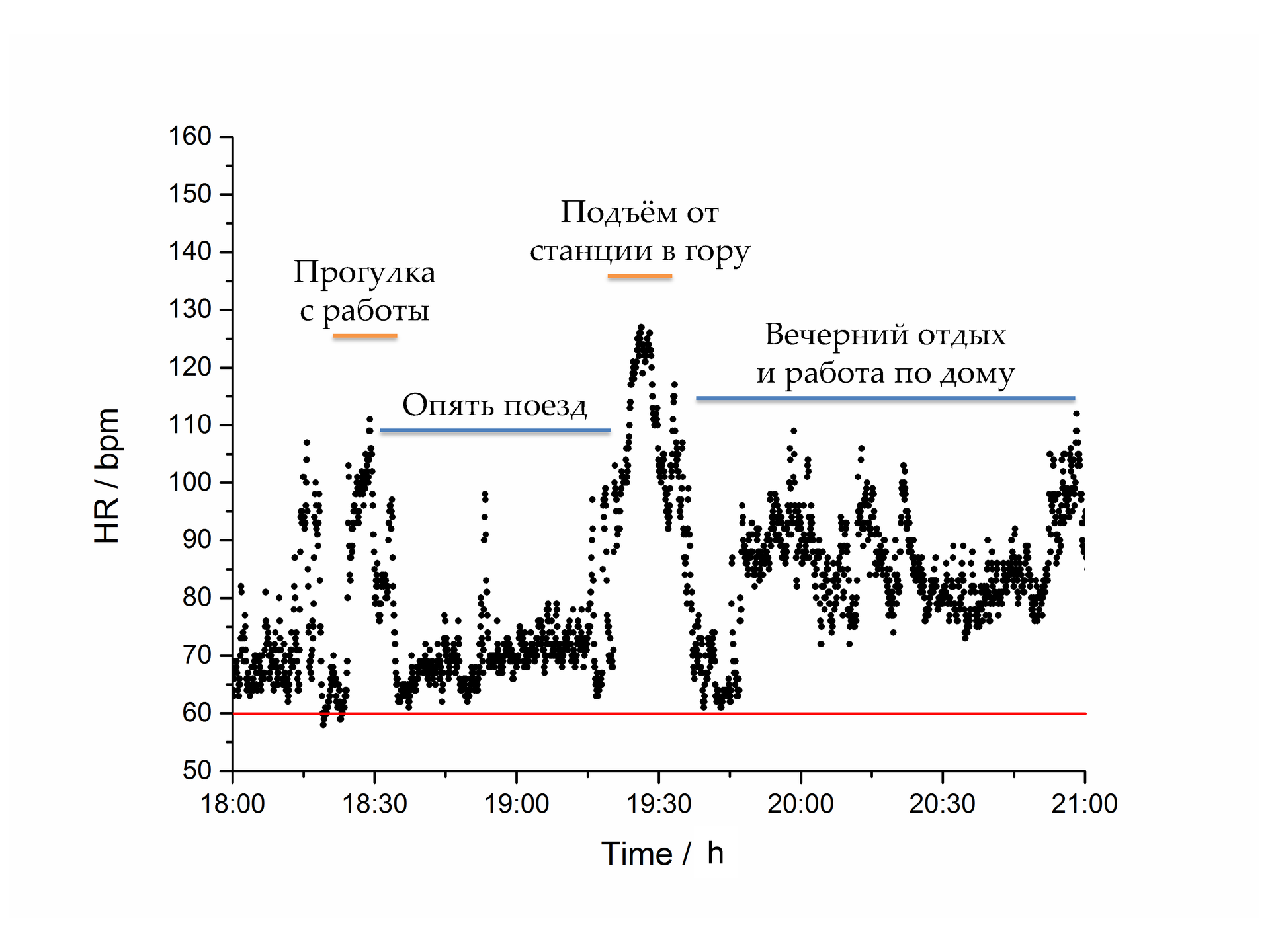
The most interesting thing happens at night. As you can see in the graph below, at night the pulse remains relatively stable - 60 beats / min, sometimes jumping up to 70. But on the pulsogram, “spikes” are clearly visible - a sharp, but not prolonged increase in the pulse. With these spikes, you can actually track the activity of a person during the night and predict when it is easiest to wake him up. It is on this principle that work: a) wristbands with wake-up function and b) sleep applications.
Opinion amateur about a dream and control over him
В последнее время стал пользоваться таким приложением. Мобильник кладу на кровать, а ночью он замеряет активность по данным встроенного акселерометра. Просыпаться получается не всегда с первого раза, но после 7-8 часов сна – встать без проблем можно. Некоторые программы записывают ещё и звук, чтобы определить храп. Если храп обнаружен, они могут выдать либо звуковой, либо вибросигнал, чтобы остановить оный.
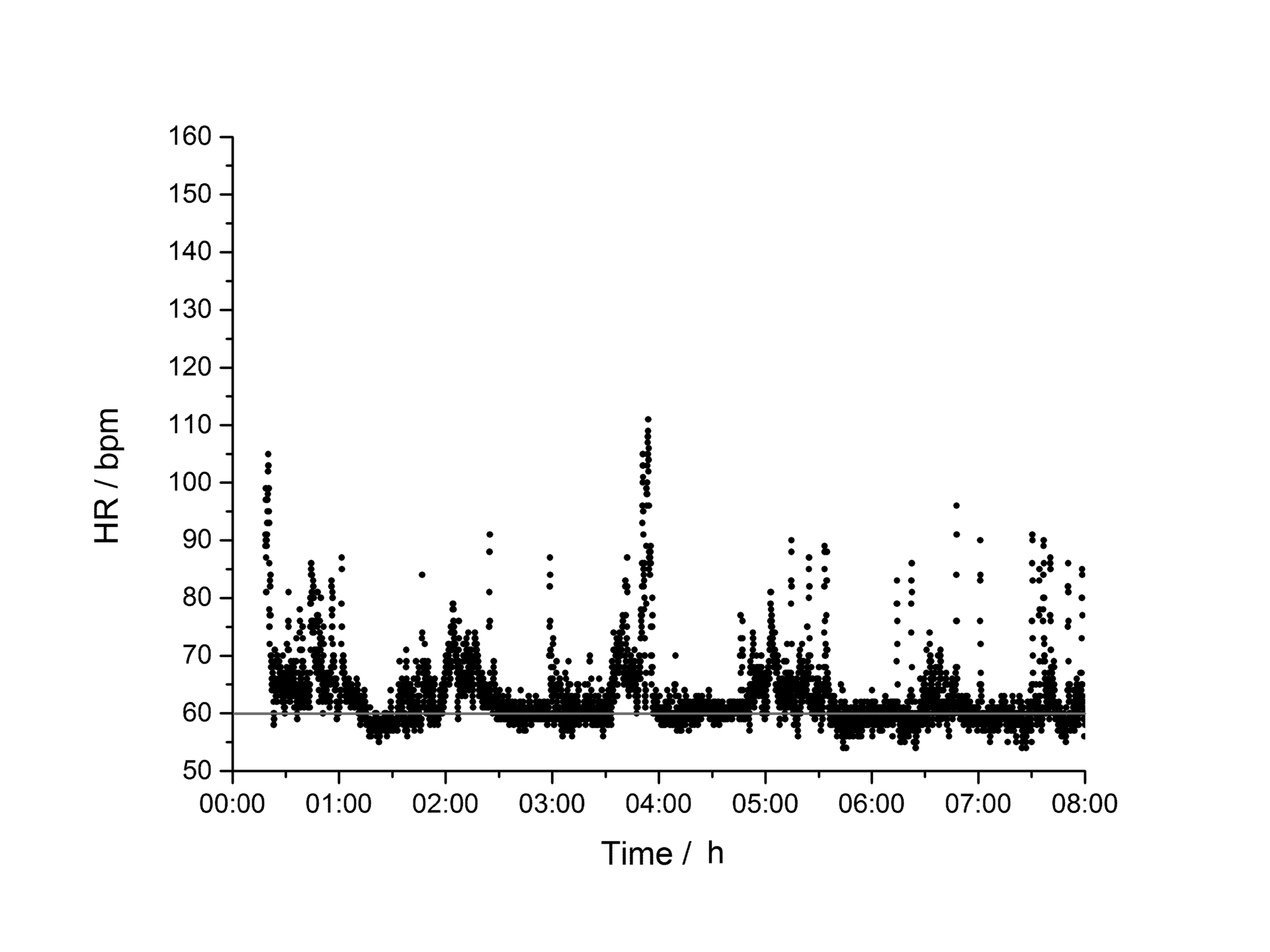
We have analyzed the main stages of the day cycle of the “office hamster”, let's turn now to the cycle of an employee who spends most of his time on his feet, in movement and working with his hands.
Laboratory Day
It is clear that at night there will be no cardinal differences, but during the day everything is completely different. Due to the fact that you constantly have to move, do something with your hands, walk from one room to another, the average pulse is 10-15-20 beats / min higher than with a sedentary lifestyle.
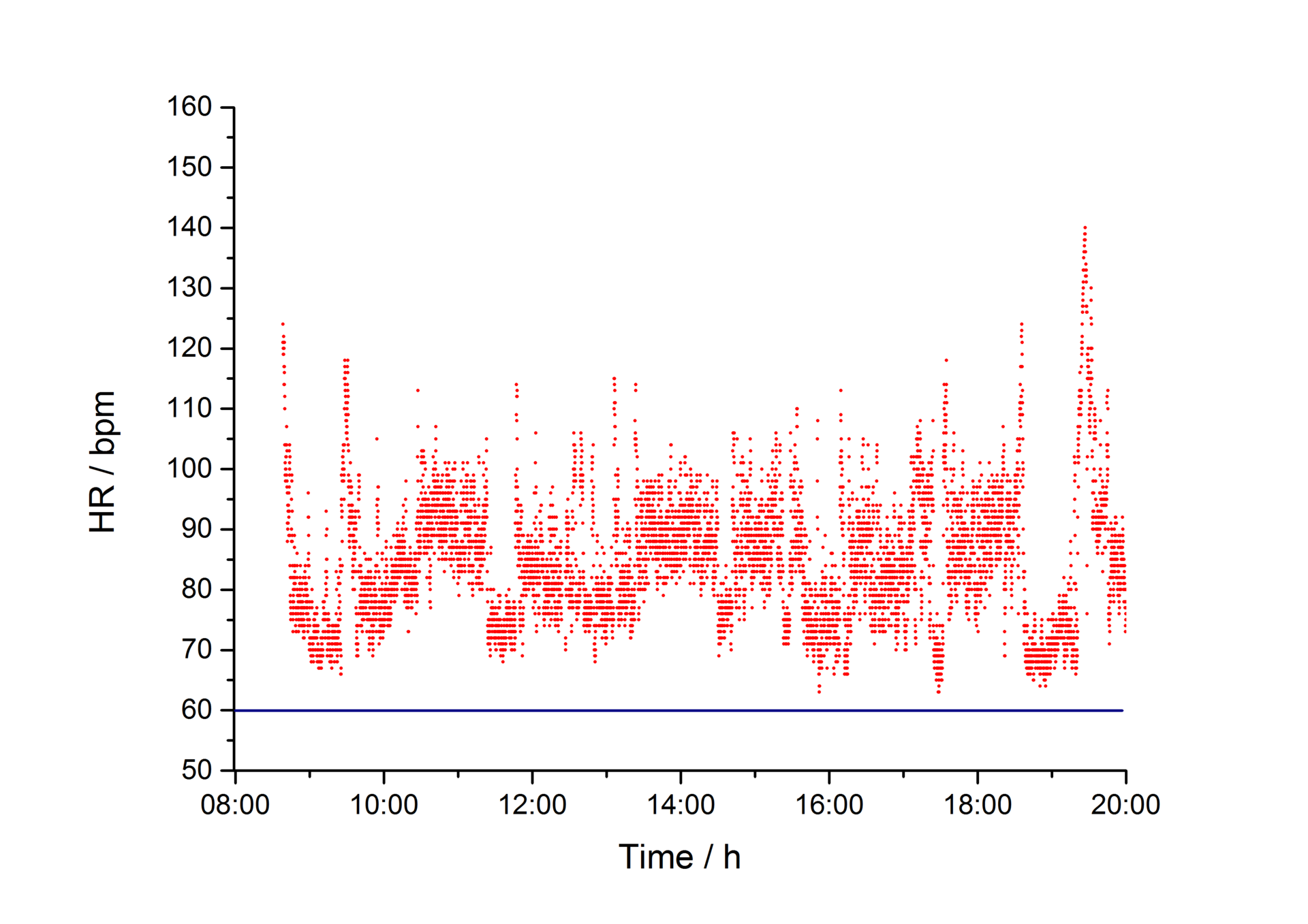
To make it a little more visual, let's build both graphs in the same coordinates:
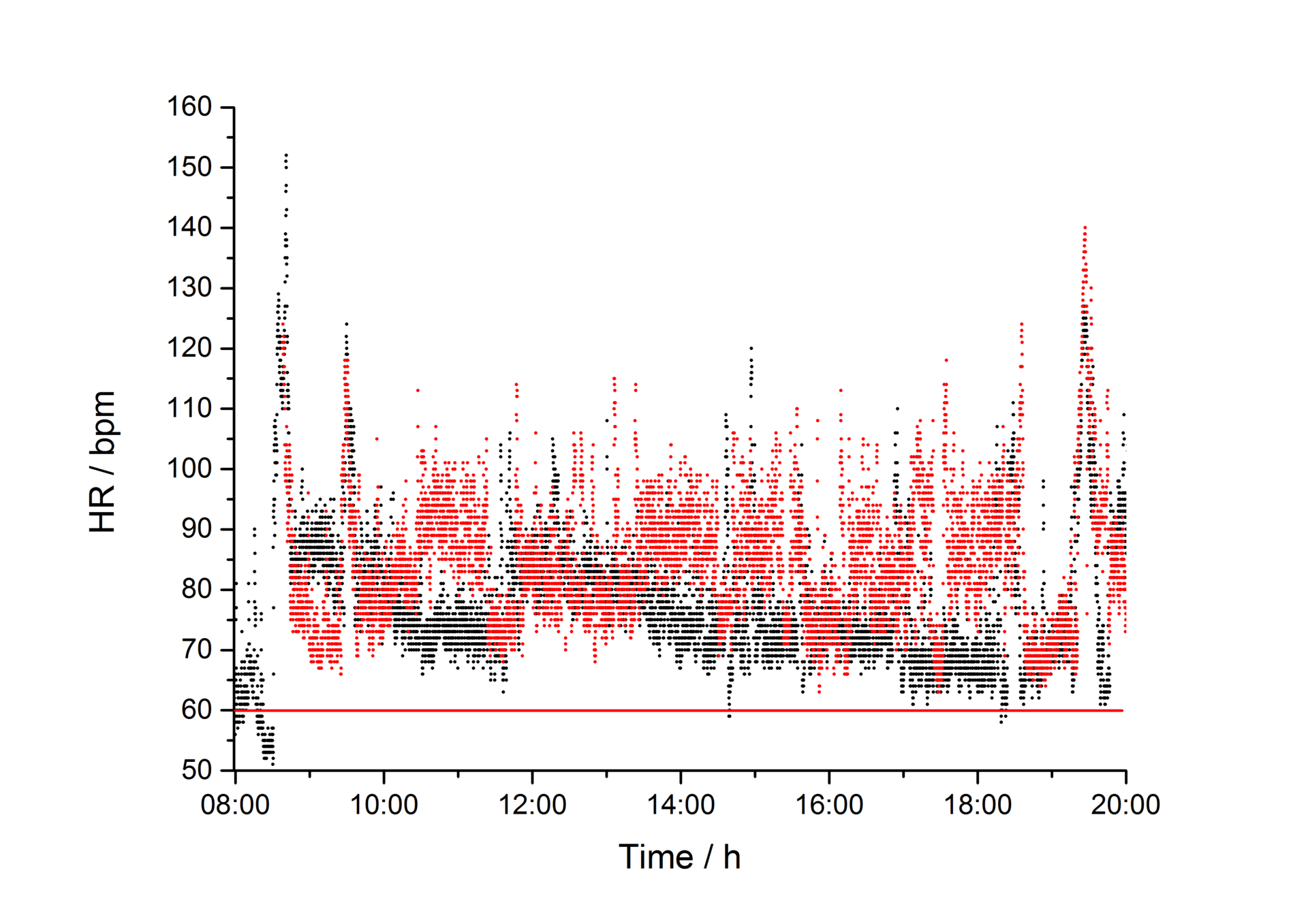
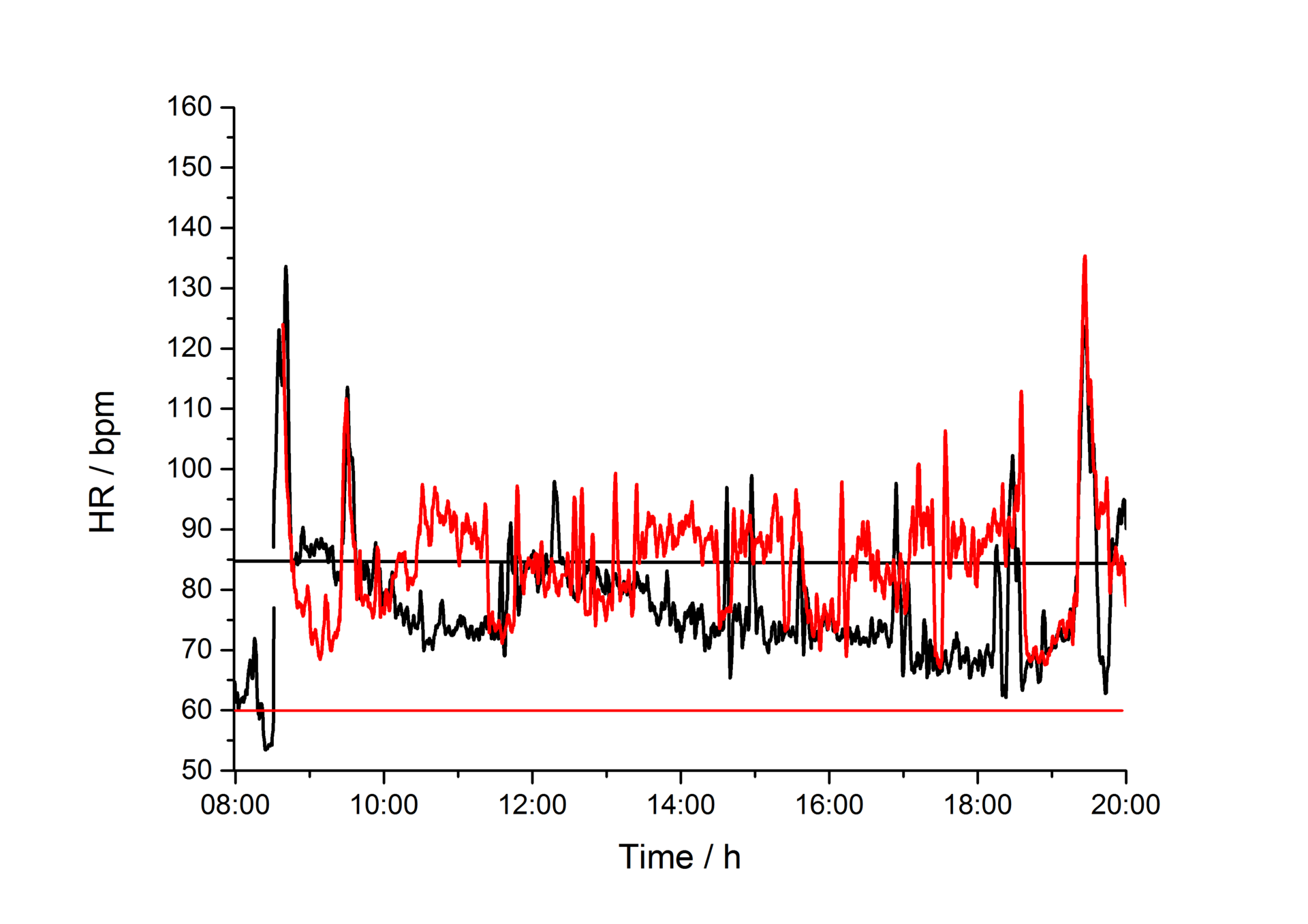
The same graph, if you add averaging
The main conclusion is the most obvious, of course: move more at work, even if the work is sedentary, then you just have to come up with a lesson that will make you walk every hour or one and a half.
Oh, sport, you are the world!
The first thing I want to tell you about is, of course, rocking or fitness - as you like. The pulsogram below shows my typical workout for about 1.5 hours. In the beginning - a warm-up, some simple exercises that help bring muscles into a tone, then a rowing machine to warm up properly, a little rest, and about 30-40 minutes of standard exercises with free weights and / or other simulators.
It is worth noting that this particular training "consumes" about 1050 kcal, which is equivalent to approximately only 2-3 Snickers 50 grams. Here you can write a whole treatise on heart rate zones and so on, but I will not, just leave a screenshot from the program.
We also love to go to the mountains with friends and colleagues, so the pulsogram and a map of one of these trips are presented below. Interestingly, a constant rise up raises the lower bar of the pulse to about 95-100 beats / min, and the average heart rate for the entire route is about 125 beats / min, which is very good for burning extra calories.
Pulsogram at mountain hike. Easily guessed lunch and photo-halt
Map, speed and elevation for clarity. For some reason, the height scale is not displayed: the maximum mark was 2380 m, the minimum - 1130m
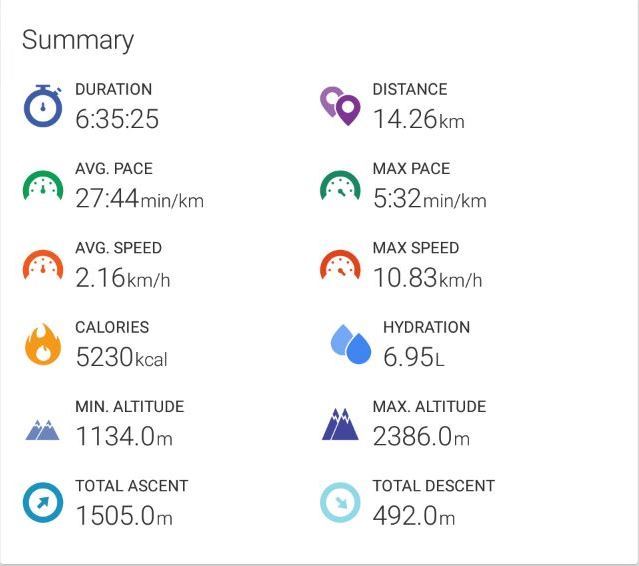
And a small sammari
Conclusion and conclusions
First , you need to move more and more often, no matter how trite it sounds. Many need a weighty argument to begin to engage in themselves, go to the gym, relax in nature and just move more. I hope that in this article I was able to clearly demonstrate that even a regular walk around the office for a glass of water or a cup of coffee makes the heart beat faster by at least a third more 20-30-40 minutes after returning to a comfortable chair. The more and more often it is reduced, the more calories are burned in the body.
Secondly, a man of modern “sugar” civilization consumes too many calories from food. Hence, the legs grow in a variety of problems: from diabetes to heart disease. At the same time, it is almost impossible to refuse products with a sugar content even at 10-15 grams per 100 grams (read the fine print on packages). There is only one way out - to burn calories yourself. In my opinion, the callous eyes inscription on the wrist - “it's time to move!” - is an excellent occasion to once again recall the food eaten at all snacks during the day and go to the fitness center.
About sugar and normal metabolism
Цитата от Djeux:
И обсуждение оного:
Проблема излишней «сахарности» еды не столько в избытке калорий, сколько в том что сахар нарушает нормальный обмен веществ. Вот хорошее видео для ознакомления:
И обсуждение оного:
Thirdly , a fitness tracker with the ability to measure the pulse is a great tool for doctors to monitor patient health and predict "problem" events. Today, the main difficulty lies in how to accumulate and process such a data array automatically, giving the doctor only a squeeze / prediagnosis.
Fourthly , unfortunately, security problems are the flip side of the advantages of fitness trackers. In fact, as I showed in the article on the pulsogram, you can track a lot of information about a person: the duration and nature of sleep, the daily routine, work style (“office hamster” and the person “in the fields”) and much more. In fact, it is a hidden spy agent on the wrist.
But back to the question posed at the beginning of the article:So who are they fitness trackers? In my opinion, fitness trackers are definitely a useful tool for monitoring your if not health, then daily activity, which indirectly affects health. If they were able to collect data on the levels of sugar and oxygen in the blood, they would become an indispensable “horse” of personalized medicine and sporting achievements.
PS: Do not forget to subscribe to the blog : You are not difficult - I am pleased! And yes, about the defects noted in the text, please write in the LAN.
PPS:
I take this opportunity to share my lecture with my dissertation.
Sometimes briefly, and sometimes not so much about the news of science and technology, you can read on my Telegram channel - welcome;)
